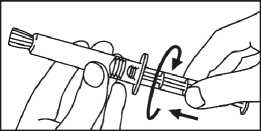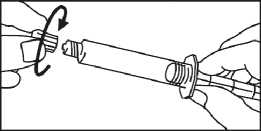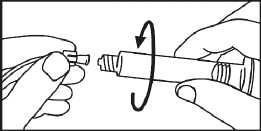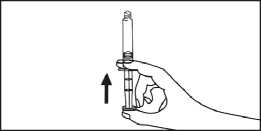Gadovist 1.0 Mmol/Ml Solution For Injection Pre-Filled Syringe/Plastic Cartridge
#
#
0
Package leaflet: Information for the patient
Gadovist 1.0 mmol/ml
solution for injection in prefilled syringe/cartridge
Gadobutrol
Read all of this leaflet carefully before you are given this
medicine because it contains important information for you.
R Keep this leaflet. You may need to read it again.
R If you have any further questions, please ask your doctor or the person giving you Gadovist (the radiologist) or the hospital/MRI-centre personnel.
R If you get any side effects talk to your doctor or radiologist. This includes any possible side effects not listed in this leaflet. See section 4.
|
What is in this leaflet | |
|
1. |
What Gadovist is and what it is used for |
|
2. |
What you need to know before you are given Gadovist |
|
3. |
How Gadovist will be given |
|
4. |
Possible side effects |
|
5. |
How to store Gadovist |
|
6. |
Contents of the pack and other information |
1. What Gadovist is and what it is used for
Gadovist is a contrast medium for magnetic resonance imaging (MRI) used for diagnostics of the brain, spine and vessels.
Gadovist can also help the doctor find out the kind (benign or malignant) of known or suspected abnormalities in the liver and kidneys.
Gadovist can also be used for MRI of abnormalities of other body regions.
It facilitates visualisation of abnormal structures or lesions and helps in the differentiation between healthy and diseased tissue.
It is for use in adults and children of all ages (including term newborn infants).
How Gadovist works
MRI is a form of medical diagnostic imaging that uses the behaviour of water molecules in normal and abnormal tissues. This is done by a complex system of magnets and radio waves. Computers record the activity and translate that into images.
Gadovist is given as an injection into your vein. This medicine is for diagnostic use only and will only be administered by healthcare professionals experienced in the field of clinical MRI practice.
2. What you need to know before you are given Gadovist Do NOT use Gadovist if you
R are allergic to gadobutrol or any of the other ingredients of this medicine (listed in section 6).
Warnings and precautions
Talk to your doctor before you are given Gadovist if you
R suffer or have suffered from an allergy (e.g. hay fever, hives) or asthma
R had a previous reaction to any contrast media R have very poor kidney function
R suffer from brain conditions with seizures (fits) or from other diseases of the nervous system
R have a heart pacemaker or if there are any implants or clips containing iron in your body.
Your doctor will decide whether the intended examination is possible or not.
R Allergy-like reactions leading to heart problems, breathing difficulties or skin reactions may occur after use of Gadovist. Severe reactions are possible. Most of these reactions occur within half an hour after you are given Gadovist. Therefore you will be observed after the examination. Delayed reactions have been observed (after hours or days) (see section 4).
Kidneys/Liver
Tell your doctor if
R your kidneys do not work properly
R you have recently had, or soon expect to have, a liver transplant.
Your doctor may decide to take a blood test to check how well your kidneys are working before making the decision to use Gadovist, especially if you are 65 years of age or older.
Neonates and infants
As kidney function is immature in babies up to 4 weeks of age and infants up to 1 year of age, Gadovist will only be used in these patients after careful consideration by the doctor.
Other medicines and Gadovist
Tell your doctor if you are taking or have recently taken or might take any other medicines.
Pregnancy and breast-feeding
Ask your doctor for advice before taking any medicine.
R Pregnancy
You must tell your doctor if you think you are, or might become, pregnant as Gadovist should not be used during pregnancy unless strictly necessary.
R Breast-feeding
Tell your doctor if you are breast-feeding or about to start breastfeeding. Your doctor will discuss whether you should continue or interrupt breast-feeding for a period of 24 hours after you receive Gadovist.
Gadovist contains sodium
This medicinal product contains less than 23 mg sodium per dose (based on the average amount given to a 70 kg person), i.e. essentially ‘sodium-free'.
3. How Gadovist will be given
Gadovist is injected into your vein using a small needle by a healthcare professional. Your MRI examination can start immediately.
After the injection you will be observed for at least 30 minutes. The usual dose
The actual dose that is right for you will depend on your body weight and on the region being examined by MRI:
In adults a single injection of 0.1 millilitre Gadovist per kg body weight is generally sufficient (this means for a person weighing 70 kg the dose would be 7 millilitre), however a further injection of up to 0.2 millilitre per kg body weight within 30 minutes of the first injection may be given. A total amount of 0.3 millilitre Gadovist per kg body weight may be given.
Further information regarding the administration and handling of Gadovist is given at the end of the leaflet.
Dosage in special patient groups
The use of Gadovist is not recommended in patients with severe kidney problems and patients who have recently had, or soon expect to have, a liver transplant. However if use is required you should only receive one dose of Gadovist during a scan and you should not receive a second injection for at least 7 days.
Neonates, infants, children and adolescents
In children of all ages (including term newborn infants) a single dose of 0.1 millilitre Gadovist per kg body weight is recommended for all examinations (see section 1).
As kidney function is immature in babies up to 4 weeks of age and infants up to 1 year of age, Gadovist will only be used in these patients after careful consideration by the doctor. Neonates and infants should only receive one dose of Gadovist during a scan and should not receive a second injection for at least 7 days.
Elderly
It is not necessary to adjust your dose if you are 65 years of age or older but you may have a blood test to check how well your kidneys are working.
If you receive more Gadovist than you should
Overdosing is unlikely. If it does happen, the doctor will treat any symptoms and may use kidney dialysis to remove Gadovist from your body.
There is no evidence to suggest that this will prevent the development of Nephrogenic Systemic Fibrosis (NSF; see section 4) and it should not be used as treatment for the condition. In some cases your heart will be checked.
If you have any further questions on the use of this medicine, ask your doctor or radiologist.
4. Possible side effects
Like all medicines, this medicine can cause side effects, although not everybody gets them.
The most serious side effects (which have been fatal or life-threatening in some cases) are:
R heart stops beating (cardiac arrest) and severe allergy-like (anaphylactoid) reactions (including stop of breathing and shock).
In addition for the following side effects life-threatening or fatal outcomes have been observed in some cases:
R shortness of breath (dyspnoea), loss of consciousness, severe allergy-like reaction, severe decrease of blood pressure may lead to collapse, stop of breathing, fluid in the lungs, swelling of mouth and throat and low blood pressure.
In rare cases:
R allergy-like reactions (hypersensitivity and anaphylaxis) may occur, including severe reactions (shock) that may need immediate medical intervention.
If you notice:
R swelling of the face, lips, tongue or throat R coughing and sneezing R difficulty breathing R itching R runny nose R hives (nettle-type rash)
tell the MRI department staff immediately. These may be the
first signs that a severe reaction is happening. Your investigation may need to be stopped and you may need further treatment.
Delayed allergy-like reactions, hours to several days after you have received Gadovist, have been observed in rare cases. If this should happen to you, tell your doctor or radiologist immediately.
The most frequently observed side effects (may affect 5 or more in 1,000 people) are:
R headache, feeling sick (nausea) and dizziness.
Most of the side effects are mild to moderate.
Possible side effects which have been observed in clinical trials
before the approval of Gadovist are listed below by how likely they are.
Common (may affect up to 1 in 10 people)
R headache R feeling sick (nausea)
Uncommon (may affect up to 1 in 100 people)
R allergy-like reaction, e.g.
P low blood pressure P hives
P swelling of the face P swelling (oedema) of the eyelid P flushing
The frequency of the following allergy-like reactions is not known:
P severe allergy-like reaction (anaphylactoid shock)
P severe decrease of blood pressure may lead to collapse (shock)
P breathing stops P fluid in the lungs
P breathing difficulties (bronchospasm)
P blueness of the lips P swelling of the mouth and throat P swelling of the throat P increased blood pressure P chest pain
P swelling of the face, throat, mouth, lips and/or tongue (angioedema)
P conjunctivitis P increased sweating P cough P sneezing P burning sensation P pale skin (pallor)
R dizziness, disturbed sense of taste, numbness and tingling R shortness of breath (dyspnoea)
R vomiting
R redness of the skin (erythema)
R itching (pruritus including generalised pruritus)
R rash (including generalised rash, small flat red spots [macular rash], small, raised, circumscribed lesions [papularrash] and itchy rash [pruritic rash])
R various kinds of injection site reactions (e.g. leakage into the surrounding tissue, burning, coldness, warmth, reddening, rash, pain or bruising)
R feeling hot
Rare (may affect up to 1 in 1,000 people)
R fainting R convulsion
R disturbed sense of smell R rapid heart beat R palpitations R dry mouth
R generally feeling unwell (malaise)
R feeling cold
Additional side effects which have been reported after the approval of Gadovist with unknown frequency (frequency cannot be estimated from the available data):
R Heart stops beating (cardiac arrest)
R There have been reports of nephrogenic systemic fibrosis - NSF (which causes hardening of the skin and may affect also soft tissue and internal organs).
Variations in blood tests of the kidney function (e.g. increase of serum creatinine) have been observed after administration of Gadovist.
Reporting of side effects
If you get any side effects talk to your doctor or radiologist. This includes any side effects not listed in this leaflet. You can also report side effects directly (see details below). By reporting side effects you can help provide more information on the safety of this medicine.
United Kingdom
Yellow Card Scheme
Website: www.mhra.gov.uk/yellowcard
Malta
ADR Reporting
Website: www.medicinesauthority.gov.mt/adrportal
5. How to store Gadovist
Keep this medicine out of the sight and reach of children.
Do not use this medicine after the expiry date which is stated on the label and the carton after EXP. The expiry date refers to the last day of that month. This medicinal product does not require any special storage conditions.
Chemical, physical and microbiological in-use stability has been demonstrated for 24 hours at 20-25 °C. From a microbiological point of view, the product should be used immediately after opening.
This medicinal product is a clear, colourless to pale yellow solution. Do not use this medicine if you notice severe discolouration or the presence of particulate matter or if the container appears defective.
Medicines should not be disposed of via wastewater or household waste. The healthcare professional will dispose of this medicine when no longer required. These measures will help to protect the environment.
6. Contents of the pack and other information What Gadovist contains The active substance is gadobutrol.
1 ml of solution for injection contains 604.72 mg gadobutrol (equivalent to 1.0 mmol gadobutrol containing 157.25 mg gadolinium).
1 prefilled syringe with 5.0 ml contains 3023.6 mg gadobutrol,
1 prefilled syringe with 7.5 ml contains 4535.4 mg gadobutrol,
1 prefilled syringe with 10 ml contains 6047.2 mg gadobutrol,
1 prefilled syringe with 15 ml contains 9070.8 mg gadobutrol,
1 prefilled syringe with 20 ml contains 12094.4 mg gadobutrol.
1 cartridge with 15 ml contains 9070.8 mg gadobutrol,
1 cartridge with 20 ml contains 12094.4 mg gadobutrol,
1 cartridge with 30 ml contains 18141.6 mg gadobutrol
The other ingredients are calcobutrol sodium (see end of section 2), trometamol, hydrochloric acid 1N and water for injections.
What Gadovist looks like and contents of the pack
Gadovist is a clear, colourless to pale yellow solution for injection. The contents of the packs are:
R 1 or 5 prefilled syringes with 5, 7.5, 10 ml solution for injection (in 10-ml glass prefilled syringe)
R 1 or 5 prefilled syringes with 15 ml solution for injection (in 17-ml glass prefilled syringes)
R 1 or 5 prefilled syringes with 20 ml solution for injection (in 20-ml glass prefilled syringe)
R 1 or 5 cartridges with 15, 20, 30 ml solution for injection (in 65-ml cartridge).
Hospital pack:
R 5 prefilled syringes with 5, 7.5, 10, 15, 20 ml solution for injection
R 5 prefilled cartridges with 15, 20, 30 ml solution for injection Not all pack sizes may be marketed.
Marketing Authorisation Holder
Bayer plc Bayer House Strawberry Hill Newbury Berkshire RG14 1JA
Manufacturer
Bayer Pharma AG Mullerstrasse 178 13353 Berlin Germany
This medicinal product is authorised in the Member States of the EEA under the following names:
|
Austria, Germany |
Gadovist 1,0 mmol/ml Injektionslosung in Fertigspritzen/Patronen |
|
Belgium, Denmark, Finland, Greece, Italy, Luxembourg, Norway, Portugal, Sweden |
Gadovist |
|
Croatia |
Gadovist 1,0 mmol/ml otopina za injekciju u napunjenoj strcaljki/ulosku |
|
France |
GADOVIST 1,0 mmol/mL, solution injectable en seringue preremplie |
|
Ireland |
Gadovist 1.0 mmol/ml solution for injection in prefilled syringe Gadovist 1.0 mmol/ml solution for injection in prefilled cartridge |
|
Netherlands |
Gadovist 1,0 mmol/ml, oplossing voor injectie in voorgevulde spuit/ patroon |
|
Spain |
Gadovist 1 mmol/ml solucion inyectable en jeringa precargada / cartucho precargado |
|
United Kingdom |
Gadovist 1.0 mmol/ml solution for injection pre-filled syringe / cartridge |
This leaflet was last revised in September 2015
The following information is intended for healthcare professionals only:
R Renal impairment
Prior to administration of Gadovist, it is recommended that all patients are screened for renal dysfunction by obtaining laboratory tests.
There have been reports of nephrogenic systemic fibrosis (NSF) associated with use of some gadolinium-containing contrast agents in patients with acute or chronic severe renal impairment (GFR < 30 ml/min/1.73 m2). Patients undergoing liver transplantation are at particular risk since the incidence of acute renal failure is high in this group. As there is a possibility that NSF may occur with Gadovist, it should therefore only be used in patients with severe renal impairment and in patients in the perioperative liver transplantation period after careful risk/benefit assessment and if the diagnostic information is essential and not available with non-contrast enhanced MRI. If it is necessary to use Gadovist, the dose should not exceed 0.1 mmol/kg body weight. More than one dose should not be used during a scan. Because of the lack of information on repeated administration, Gadovist injections should not be repeated unless the interval between injections is at least 7 days.
As the renal clearance of Gadovist may be impaired in the elderly, it is particularly important to screen patients aged 65 years and older for renal dysfunction.
Haemodialysis shortly after Gadovist administration may be useful at removing Gadovist from the body. There is no evidence to support the initiation of haemodialysis for prevention or treatment of NSF in patients not already undergoing haemodialysis.
R Pregnancy and breast-feeding
Gadovist should not be used during pregnancy unless the clinical condition of the woman requires use of Gadovist.
Continuing or discontinuing of breast-feeding for a period of 24 hours after administration of Gadovist, should be at the discretion of the doctor and lactating mother.
R Hypersensitivity reactions
As with other intravenous contrast agents, Gadovist can be associated with anaphylactoid/hypersensitivity or other idiosyncratic reactions, characterized by cardiovascular, respiratory or cutaneous manifestations, and ranging to severe reactions including shock. In general, patients with cardiovascular disease are more susceptible to serious or even fatal outcomes of severe hypersensitivity reactions.
The risk of hypersensitivity reactions may be higher in case of:
P previous reaction to contrast media P history of bronchial asthma P history of allergic disorders
In patients with an allergic disposition the decision to use Gadovist must be made after particularly careful evaluation of the risk-benefit ratio.
Most of these reactions occur within half an hour of administration. Therefore, post-procedure observation of the patient is recommended.
Medication for the treatment of hypersensitivity reactions as well as preparedness for institution of emergency measures are necessary.
Delayed reactions (after hours up to several days) have been rarely observed.
R Seizure disorders
Like with other gadolinium containing contrast agents special precaution is necessary in patients with a low threshold for seizures.
R Overdose
In case of inadvertent overdosage, cardiovascular monitoring (including ECG) and control of renal function are recommended as a measure of precaution.
In case of overdose in patients with renal insufficiency, Gadovist can be removed by haemodialysis. After 3 haemodialysis sessions approx. 98 % of the agent are removed from the body. However, there is no evidence that haemodialysis is suitable for prevention of nephrogenic systemic fibrosis (NSF).
Packaging Technology Berlin sgmgj_page 1_Bayer Pharma AG
client: 0021_material-no.: 85018140_PZ: 2589C-3_code-no.: 97
name: LF-INS-Gadovist 1,0 PFS_country: GB/-/BPH
rotors: Black_
version: 15.09.2015/01 approval: dimension: 297 x 594 mm
0
► Before injection
This product is intended for single use only.
This medicinal product is a clear, colourless to pale yellow solution. It should be visually inspected before use.
Gadovist should not be used in case of severe discoloration, the occurrence of particulate matter or a defective container.
► Instructions for use Prefilled syringes
The prefilled syringe must be taken from the pack and prepared for the injection immediately before the administration.
The tip cap should be removed from the prefilled syringe immediately before use.
Glass syringe only:
HAND INJECTION

syringe


Cartridges
Administration of contrast media should be performed by qualified personnel with the appropriate procedures and equipment.
Sterile technique must be used in all injections involving contrast media.
The contrast medium must be administered by means of a MEDRAD Spectris® type injector.
Instructions of the device manufacturer must be followed.
Any solution not used in one examination is to be discarded in accordance with local requirements.
Shelf life after first opening of the container
Any solution for injection not used in one examination must be discarded. Chemical, physical and microbiological in-use stability has been demonstrated for 24 hours at 20-25 °C. From a microbiological point of view, the product should be used immediately. If not used immediately, in-use storage times and conditions prior to use are the responsibility of the user.
The peel-off tracking label on the syringes/cartridges should be stuck onto the patient record to enable accurate recording of the gadolinium contrast agent used. The dose used should also be recorded. If electronic patient records are used, the name of the product, the batch number and the dose should be entered into the patient record.
Posology ► Adults CNS indications
The recommended dose for adults is 0.1 mmol per kilogram body weight (mmol/kg BW). This is equivalent to 0.1 ml/kg BW of the 1.0 M solution.
If a strong clinical suspicion of a lesion persists despite an unremarkable MRI or when more accurate information might influence therapy of the patient, a further injection of up to
0.2 ml/kg BW within 30 minutes of the first injection may be performed.
Whole Body MRI (except MRA)
In general, the administration of 0.1 ml Gadovist per kg body weight is sufficient to answer the clinical question.
CE-MRA
Imaging of 1 field of view (FOV): 7.5 ml for body weight below 75 kg; 10 ml for body weight of 75 kg and higher (corresponding to 0.1-0.15 mmol/kg BW).
Imaging of > 1 field of view (FOV): 15 ml for body weight below 75 kg; 20 ml for body weight of 75 kg and higher (corresponding to 0.2-0.3 mmol/kg Bw).
► Paediatric population
For children of all ages (including term neonates) the recommended dose is 0.1 mmol gadobutrol per kg body weight (equivalent to 0.1 ml Gadovist per kg body weight) for all indications (see section 1).
Due to immature renal function in neonates up to 4 weeks of age and infants up to 1 year of age, Gadovist should only be used in these patients after careful consideration at a dose not exceeding 0.1 mmol/kg body weight. More than one dose should not be used during a scan. Because of the lack of information on repeated administration, Gadovist injections should not be repeated unless the interval between injections is at least 7 days.
Imaging
The dose required is administered intravenously as a bolus injection. Contrast-enhanced MRI can commence immediately afterwards (shortly after the injection depending on the pulse sequences used and the protocol for the examination).
Optimal signal enhancement is observed during arterial first pass for CE-MRA and within a period of about 15 minutes after injection of Gadovist for CNS indications (time depending on type of lesion/tissue).
T1 -weighted scanning sequences are particularly suitable for contrast-enhanced examinations.
Further information regarding the use of Gadovist is given in section 3 of the leaflet.
Packaging Technology Berlin sgmgj_page 2_Bayer Pharma AG
client: 0021_material-no.: 85018140_PZ: 2589C-3_code-no.: 97
name: LF-INS-Gadovist 1,0 PFS_country: GB/-/BPH
colors: Black_
version: 15.09.2015/01 approval: dimension: 297 x 594 mm
0
0



0
Package leaflet: Information for the patient
Gadovist 1.0 mmol/ml
solution for injection in prefilled syringe/cartridge
Gadobutrol
Read all of this leaflet carefully before you are given this
medicine because it contains important information for you.
R Keep this leaflet. You may need to read it again.
R If you have any further questions, please ask your doctor or the person giving you Gadovist (the radiologist) or the hospital/MRI-centre personnel.
R If you get any side effects talk to your doctor or radiologist. This includes any possible side effects not listed in this leaflet. See section 4.
|
What is in this leaflet | |
|
1. |
What Gadovist is and what it is used for |
|
2. |
What you need to know before you are given Gadovist |
|
3. |
How Gadovist will be given |
|
4. |
Possible side effects |
|
5. |
How to store Gadovist |
|
6. |
Contents of the pack and other information |
1. What Gadovist is and what it is used for
Gadovist is a contrast medium for magnetic resonance imaging (MRI) used for diagnostics of the brain, spine and vessels.
Gadovist can also help the doctor find out the kind (benign or malignant) of known or suspected abnormalities in the liver and kidneys.
Gadovist can also be used for MRI of abnormalities of other body regions.
It facilitates visualisation of abnormal structures or lesions and helps in the differentiation between healthy and diseased tissue.
It is for use in adults and children of all ages (including term newborn infants).
How Gadovist works
MRI is a form of medical diagnostic imaging that uses the behaviour of water molecules in normal and abnormal tissues. This is done by a complex system of magnets and radio waves. Computers record the activity and translate that into images.
Gadovist is given as an injection into your vein. This medicine is for diagnostic use only and will only be administered by healthcare professionals experienced in the field of clinical MRI practice.
2. What you need to know before you are given Gadovist Do NOT use Gadovist if you
R are allergic to gadobutrol or any of the other ingredients of this medicine (listed in section 6).
Warnings and precautions
Talk to your doctor before you are given Gadovist if you R suffer or have suffered from an allergy (e.g. hay fever, hives) or asthma
R had a previous reaction to any contrast media R have very poor kidney function
R suffer from brain conditions with seizures (fits) or from other diseases of the nervous system
R have a heart pacemaker or if there are any implants or clips containing iron in your body.
Your doctor will decide whether the intended examination is possible or not.
R Allergy-like reactions leading to heart problems, breathing difficulties or skin reactions may occur after use of Gadovist. Severe reactions are possible. Most of these reactions occur within half an hour after you are given Gadovist. Therefore you will be observed after the examination. Delayed reactions have been observed (after hours or days) (see section 4). Kidneys/Liver Tell your doctor if
R your kidneys do not work properly R you have recently had, or soon expect to have, a liver transplant.
Your doctor may decide to take a blood test to check how well your kidneys are working before making the decision to use Gadovist, especially if you are 65 years of age or older.
Neonates and infants
As kidney function is immature in babies up to 4 weeks of age and infants up to 1 year of age, Gadovist will only be used in these patients after careful consideration by the doctor.
Other medicines and Gadovist
Tell your doctor if you are taking or have recently taken or might take any other medicines.
Pregnancy and breast-feeding
Ask your doctor for advice before taking any medicine.
R Pregnancy
You must tell your doctor if you think you are, or might become, pregnant as Gadovist should not be used during pregnancy unless strictly necessary.
R Breast-feeding
Tell your doctor if you are breast-feeding or about to start breastfeeding. Your doctor will discuss whether you should continue or interrupt breast-feeding for a period of 24 hours after you receive Gadovist.
Gadovist contains sodium
This medicinal product contains less than 23 mg sodium per dose (based on the average amount given to a 70 kg person), i.e. essentially ‘sodium-free'.
3. How Gadovist will be given
Gadovist is injected into your vein using a small needle by a healthcare professional. Your MRI examination can start immediately.
After the injection you will be observed for at least 30 minutes. The usual dose
The actual dose that is right for you will depend on your body weight and on the region being examined by MRI:
In adults a single injection of 0.1 millilitre Gadovist per kg body weight is generally sufficient (this means for a person weighing 70 kg the dose would be 7 millilitre), however a further injection of up to 0.2 millilitre per kg body weight within 30 minutes of the first injection may be given. A total amount of 0.3 millilitre Gadovist per kg body weight may be given.
Further information regarding the administration and handling of Gadovist is given at the end of the leaflet.
Dosage in special patient groups
The use of Gadovist is not recommended in patients with severe kidney problems and patients who have recently had, or soon expect to have, a liver transplant. However if use is required you should only receive one dose of Gadovist during a scan and you should not receive a second injection for at least 7 days. Neonates, infants, children and adolescents In children of all ages (including term newborn infants) a single dose of 0.1 millilitre Gadovist per kg body weight is recommended for all examinations (see section 1).
As kidney function is immature in babies up to 4 weeks of age and infants up to 1 year of age, Gadovist will only be used in these patients after careful consideration by the doctor. Neonates and infants should only receive one dose of Gadovist during a scan and should not receive a second injection for at least 7 days. Elderly
It is not necessary to adjust your dose if you are 65 years of age or older but you may have a blood test to check how well your kidneys are working.
If you receive more Gadovist than you should
Overdosing is unlikely. If it does happen, the doctor will treat any symptoms and may use kidney dialysis to remove Gadovist from your body.
There is no evidence to suggest that this will prevent the development of Nephrogenic Systemic Fibrosis (NSF; see section 4) and it should not be used as treatment for the condition. In some cases your heart will be checked.
If you have any further questions on the use of this medicine, ask your doctor or radiologist.
4. Possible side effects
Like all medicines, this medicine can cause side effects, although not everybody gets them.
The most serious side effects (which have been fatal or life-threatening in some cases) are:
R heart stops beating (cardiac arrest) and severe allergy-like (anaphylactoid) reactions (including stop of breathing and shock).
In addition for the following side effects life-threatening or fatal outcomes have been observed in some cases:
R shortness of breath (dyspnoea), loss of consciousness, severe allergy-like reaction, severe decrease of blood pressure may lead to collapse, stop of breathing, fluid in the lungs, swelling of mouth and throat and low blood pressure.
In rare cases:
R allergy-like reactions (hypersensitivity and anaphylaxis) may occur, including severe reactions (shock) that may need immediate medical intervention.
If you notice:
R swelling of the face, lips, tongue or throat R coughing and sneezing R difficulty breathing R itching R runny nose R hives (nettle-type rash)
tell the MRI department staff immediately. These may be the
first signs that a severe reaction is happening. Your investigation may need to be stopped and you may need further treatment. Delayed allergy-like reactions, hours to several days after you have received Gadovist, have been observed in rare cases. If this should happen to you, tell your doctor or radiologist immediately.
The most frequently observed side effects (may affect 5 or more in 1,000 people) are:
R headache, feeling sick (nausea) and dizziness.
Most of the side effects are mild to moderate.
Possible side effects which have been observed in clinical trials before the approval of Gadovist are listed below by how likely they are.
Common (may affect up to 1 in 10 people)
R headache R feeling sick (nausea)
Uncommon (may affect up to 1 in 100 people)
R allergy-like reaction, e.g.
P low blood pressure P hives
P swelling of the face P swelling (oedema) of the eyelid P flushing
The frequency of the following allergy-like reactions is not known:
P severe allergy-like reaction (anaphylactoid shock)
P severe decrease of blood pressure may lead to collapse (shock)
P breathing stops P fluid in the lungs
P breathing difficulties (bronchospasm)
P blueness of the lips P swelling of the mouth and throat P swelling of the throat P increased blood pressure P chest pain
P swelling of the face, throat, mouth, lips and/or tongue (angioedema)
P conjunctivitis P increased sweating P cough P sneezing P burning sensation P pale skin (pallor)
R dizziness, disturbed sense of taste, numbness and tingling R shortness of breath (dyspnoea)
R vomiting
R redness of the skin (erythema)
R itching (pruritus including generalised pruritus)
R rash (including generalised rash, small flat red spots [macular rash], small, raised, circumscribed lesions [papularrash] and itchy rash [pruritic rash])
R various kinds of injection site reactions (e.g. leakage into the surrounding tissue, burning, coldness, warmth, reddening, rash, pain or bruising)
R feeling hot
Rare (may affect up to 1 in 1,000 people)
R fainting R convulsion
R disturbed sense of smell R rapid heart beat R palpitations R dry mouth
R generally feeling unwell (malaise)
R feeling cold
Additional side effects which have been reported after the approval of Gadovist with unknown frequency (frequency cannot be estimated from the available data):
R Heart stops beating (cardiac arrest)
R There have been reports of nephrogenic systemic fibrosis - NSF (which causes hardening of the skin and may affect also soft tissue and internal organs).
Variations in blood tests of the kidney function (e.g. increase of serum creatinine) have been observed after administration of Gadovist.
Reporting of side effects
If you get any side effects talk to your doctor or radiologist. This includes any side effects not listed in this leaflet. You can also report side effects directly (see details below). By reporting side effects you can help provide more information on the safety of this medicine.
United Kingdom
Yellow Card Scheme
Website: www.mhra.gov.uk/yellowcard
Malta
ADR Reporting
Website: www.medicinesauthority.gov.mt/adrportal
5. How to store Gadovist
Keep this medicine out of the sight and reach of children.
Do not use this medicine after the expiry date which is stated on the label and the carton after EXP. The expiry date refers to the last day of that month. This medicinal product does not require any special storage conditions.
Chemical, physical and microbiological in-use stability has been demonstrated for 24 hours at 20-25 °C. From a microbiological point of view, the product should be used immediately after opening.
This medicinal product is a clear, colourless to pale yellow solution. Do not use this medicine if you notice severe discolouration or the presence of particulate matter or if the container appears defective.
Medicines should not be disposed of via wastewater or household waste. The healthcare professional will dispose of this medicine when no longer required. These measures will help to protect the environment.
6. Contents of the pack and other information What Gadovist contains The active substance is gadobutrol.
1 ml of solution for injection contains 604.72 mg gadobutrol (equivalent to 1.0 mmol gadobutrol containing 157.25 mg gadolinium).
1 prefilled syringe with 5.0 ml contains 3023.6 mg gadobutrol,
1 prefilled syringe with 7.5 ml contains 4535.4 mg gadobutrol,
1 prefilled syringe with 10 ml contains 6047.2 mg gadobutrol,
1 prefilled syringe with 15 ml contains 9070.8 mg gadobutrol,
1 prefilled syringe with 20 ml contains 12094.4 mg gadobutrol.
1 cartridge with 15 ml contains 9070.8 mg gadobutrol,
1 cartridge with 20 ml contains 12094.4 mg gadobutrol,
1 cartridge with 30 ml contains 18141.6 mg gadobutrol The other ingredients are calcobutrol sodium (see end of section 2), trometamol, hydrochloric acid 1N and water for injections.
What Gadovist looks like and contents of the pack
Gadovist is a clear, colourless to pale yellow solution for injection. The contents of the packs are:
R 1 or 5 prefilled syringes with 5, 7.5, 10 ml solution for injection (in 10-ml plastic prefilled syringe)
R 1 or 5 prefilled syringes with 15 ml solution for injection (in 20-ml plastic prefilled syringe)
R 1 or 5 prefilled syringes with 20 ml solution for injection (in plastic prefilled syringe)
R 1 or 5 cartridges with 15, 20, 30 ml solution for injection (in 65-ml cartridge).
Hospital pack:
R 5 prefilled syringes with 5, 7.5, 10, 15, 20 ml solution for injection
R 5 prefilled cartridges with 15, 20, 30 ml solution for injection Not all pack sizes may be marketed.
Marketing Authorisation Holder
Bayer plc
Bayer House
Strawberry Hill
Newbury
Berkshire
RG14 1JA
Manufacturer
Bayer Pharma AG
Mullerstrasse 178
13353 Berlin
Germany
This medicinal product is authorised in the Member States of the EEA under the following names:
|
Austria, Germany |
Gadovist 1,0 mmol/ml Injektionslosung in Fertigspritzen/Patronen |
|
Belgium, Denmark, Finland, Greece, Italy, Luxembourg, Norway, Portugal, Sweden |
Gadovist |
|
Croatia |
Gadovist 1,0 mmol/ml otopina za injekciju u napunjenoj strcaljki/ulosku |
|
France |
GADOVIST 1,0 mmol/mL, solution injectable en seringue preremplie |
|
Ireland |
Gadovist 1.0 mmol/ml solution for injection in prefilled syringe Gadovist 1.0 mmol/ml solution for injection in prefilled cartridge |
|
Netherlands |
Gadovist 1,0 mmol/ml, oplossing voor injectie in voorgevulde spuit/ patroon |
|
Spain |
Gadovist 1 mmol/ml solucion inyectable en jeringa precargada / cartucho precargado |
|
United Kingdom |
Gadovist 1.0 mmol/ml solution for injection pre-filled syringe / cartridge |
This leaflet was last revised in September 2015
The following information is intended for healthcare professionals only:
R Renal impairment
Prior to administration of Gadovist, it is recommended that all patients are screened for renal dysfunction by obtaining laboratory tests.
There have been reports of nephrogenic systemic fibrosis (NSF) associated with use of some gadolinium-containing contrast agents in patients with acute or chronic severe renal impairment (GFR < 30 ml/min/1.73 m2). Patients undergoing liver transplantation are at particular risk since the incidence of acute renal failure is high in this group. As there is a possibility that NSF may occur with Gadovist, it should therefore only be used in patients with severe renal impairment and in patients in the perioperative liver transplantation period after careful risk/benefit assessment and if the diagnostic information is essential and not available with non-contrast enhanced MRI. If it is necessary to use Gadovist, the dose should not exceed 0.1 mmol/kg body weight. More than one dose should not be used during a scan. Because of the lack of information on repeated administration, Gadovist injections should not be repeated unless the interval between injections is at least 7 days.
As the renal clearance of Gadovist may be impaired in the elderly, it is particularly important to screen patients aged 65 years and older for renal dysfunction.
Haemodialysis shortly after Gadovist administration may be useful at removing Gadovist from the body. There is no evidence to support the initiation of haemodialysis for prevention or treatment of NSF in patients not already undergoing haemodialysis.
R Pregnancy and breast-feeding
Gadovist should not be used during pregnancy unless the clinical condition of the woman requires use of Gadovist.
Continuing or discontinuing of breast-feeding for a period of 24 hours after administration of Gadovist, should be at the discretion of the doctor and lactating mother.
R Hypersensitivity reactions
As with other intravenous contrast agents, Gadovist can be associated with anaphylactoid/hypersensitivity or other idiosyncratic reactions, characterized by cardiovascular, respiratory or cutaneous manifestations, and ranging to severe reactions including shock. In general, patients with cardiovascular disease are more susceptible to serious or even fatal outcomes of severe hypersensitivity reactions.
The risk of hypersensitivity reactions may be higher in case of:
P previous reaction to contrast media P history of bronchial asthma P history of allergic disorders
In patients with an allergic disposition the decision to use Gadovist must be made after particularly careful evaluation of the risk-benefit ratio.
Most of these reactions occur within half an hour of administration. Therefore, post-procedure observation of the patient is recommended.
Medication for the treatment of hypersensitivity reactions as well as preparedness for institution of emergency measures are necessary.
Delayed reactions (after hours up to several days) have been rarely observed.
R Seizure disorders
Like with other gadolinium containing contrast agents special precaution is necessary in patients with a low threshold for seizures.
R Overdose
In case of inadvertent overdosage, cardiovascular monitoring (including ECG) and control of renal function are recommended as a measure of precaution.
In case of overdose in patients with renal insufficiency, Gadovist can be removed by haemodialysis. After 3 haemodialysis sessions approx. 98 % of the agent are removed from the body. However, there is no evidence that haemodialysis is suitable for prevention of nephrogenic systemic fibrosis (NSF).
Packaging Technology Berlin sgrfh_page 1_Bayer Pharma AG
client: 0021 material-no.: 85001825 PZ: 2589C-3 code-no.: 72
name: LF-INS-Gadovist 1,0 PFSP_country: GB/-/BPH
rotors: Black_
version: 07.09.2015/02 approval: dimension: 297 x 594 mm
0
0
► Before injection
This product is intended for single use only.
This medicinal product is a clear, colourless to pale yellow solution. It should be visually inspected before use.
Gadovist should not be used in case of severe discoloration, the occurrence of particulate matter or a defective container.
► Instructions for use Prefilled syringes
The prefilled syringe must be taken from the pack and prepared for the injection immediately before the administration.
The tip cap should be removed from the prefilled syringe immediately before use.
Plastic syringe only:
HAND INJECTION
INJECTION WITH A POWER INJECTOR




2. Take syringe and plunger rod out of the package
2. Take syringe out of the package


3. Turn clock-wise the plunger rod into the syringe
3. Open the cap with a twist


4. Open the cap with a twist
4. Connect the tip of the syringe to the tubing system clockwise and go on according to the instructions of the device manufacturer

5. Remove the air in the syringe
Cartridges
Administration of contrast media should be performed by qualified personnel with the appropriate procedures and equipment.
Sterile technique must be used in all injections involving contrast media.
The contrast medium must be administered by means of a MEDRAD Spectris® type injector.
Instructions of the device manufacturer must be followed.
Any solution not used in one examination is to be discarded in accordance with local requirements.
Shelf life after first opening of the container
Any solution for injection not used in one examination must be discarded. Chemical, physical and microbiological in-use stability has been demonstrated for 24 hours at 20-25 °C. From a microbiological point of view, the product should be used immediately. If not used immediately, in-use storage times and conditions prior to use are the responsibility of the user.
The peel-off tracking label on the syringes/cartridges should be stuck onto the patient record to enable accurate recording of the gadolinium contrast agent used. The dose used should also be recorded. If electronic patient records are used, the name of the product, the batch number and the dose should be entered into the patient record.
Posology
► Adults
CNS indications
The recommended dose for adults is 0.1 mmol per kilogram body weight (mmol/kg BW). This is equivalent to 0.1 ml/kg BW of the 1.0 M solution.
If a strong clinical suspicion of a lesion persists despite an unremarkable MRI or when more accurate information might influence therapy of the patient, a further injection of up to 0.2 ml/kg BW within 30 minutes of the first injection may be performed.
Whole Body MRI (except MRA)
In general, the administration of 0.1 ml Gadovist per kg body weight is sufficient to answer the clinical question.
CE-MRA
Imaging of 1 field of view (FOV): 7.5 ml for body weight below 75 kg; 10 ml for body weight of 75 kg and higher (corresponding to 0.1-0.15 mmol/kg BW).
Imaging of > 1 field of view (FOV): 15 ml for body weight below 75 kg; 20 ml for body weight of 75 kg and higher (corresponding to 0.2-0.3 mmol/kg Bw).
► Paediatric population
For children of all ages (including term neonates) the recommended dose is 0.1 mmol gadobutrol per kg body weight (equivalent to 0.1 ml Gadovist per kg body weight) for all indications (see section 1).
Due to immature renal function in neonates up to 4 weeks of age and infants up to 1 year of age, Gadovist should only be used in these patients after careful consideration at a dose not exceeding 0.1 mmol/kg body weight. More than one dose should not be used during a scan. Because of the lack of information on repeated administration, Gadovist injections should not be repeated unless the interval between injections is at least 7 days.
Imaging
The dose required is administered intravenously as a bolus injection. Contrast-enhanced MRI can commence immediately afterwards (shortly after the injection depending on the pulse sequences used and the protocol for the examination).
Optimal signal enhancement is observed during arterial first pass for CE-MRA and within a period of about 15 minutes after injection of Gadovist for CNS indications (time depending on type of lesion/tissue).
T1 -weighted scanning sequences are particularly suitable for contrast-enhanced examinations.
Further information regarding the use of Gadovist is given in section 3 of the leaflet.
Packaging Technology Berlin sgrfh_page 2_Bayer Pharma AG
client: 0021 material-no.: 85001825 PZ: 2589C-3 code-no.: 72
name: LF-INS-Gadovist 1,0 PFSP_country: GB/-/BPH
colors: Black_
version: 07.09.2015/02 approval: dimension: 297 x 594 mm
0


85001825_02.indd 0 07.09.2015 15:46:21